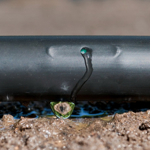
Drip Irrigation Emitters Difference?
Drip Irrigation users can select from a number of different types of drippers to suit different watering needs. Drippers, also referred to as emitters, are the end devices which deliver water to plants in a specific manner. By understanding the differences in emitter types, users can more easily select the right emitter for any application.
In a typical drip irrigation system, tubing is laid out from the water source to the end of the planting area. This mainline tubing may have emitters attached directly to it at points adjacent to individual plants. Smaller tubing can also be installed between the mainline tubing and individual plants with emitters attached to the ends of the smaller tubing. Emitters might also be imbedded within certain sizes of tubing, called drip tubing or drip tape, with the emitters spaced at specific distances apart within the tubing. Since systems can be configured in many ways, it is not uncommon to find any combination of different types of emitters within a system.

The most common emitter is known as a dripper or button dripper, and emits water at a specific rate, Drippers are commonly used to water individual plants, and most drippers are color-coded so the user can easily identify the different flow rates. Cleanable drippers have a removable cap to allow the user to remove small obstructions within the dripper. A dripper that is not cleanable would need to be replaced if it becomes clogged. Pressure compensating drippers deliver a precise amount of water regardless of changes in pressure due to long tubing runs or changes in terrain elevations. Adjustable drippers allow the user to vary the amount of water emitted, usually between 0 and 20 gph, by turning the dripper cap or a small valve.
Drippers are available with varying patterns with which water exits the dripper. Typical drippers just drip water from the end. Some adjustable drippers emit water in several small individual streams out to a diameter from a few inches to a few feet in arcs of 360 degrees or 180 degrees. A bubbler type of dripper produces a gentle umbrella pattern for rapid watering near the root zone. A "vortex" type of dripper emits water in a steady circular pattern for a larger coverage area than a bubbler. The inlet side of drippers is usually a barbed end designed to be connected to 1/4 tubing or inserted into a hole in the side of larger diameter tubing. Emitters with threaded ends are available to allow some types of drippers to be inserted into rigid 1/4 risers or into a hole drilled into PVC tubing. Some drippers even come with a built-in stake to secure it into the ground. Adjustable (stream), bubbler, and vortex drippers can be used for plants which require a larger wetting area than standard drippers can provide, such as plants with wide root zones or plants in larger containers
.
.

Spray Jet emitters spray water out to a larger diameter than typical drippers in arcs of 90, 180 or 360 degrees, and the flow rate is usually adjustable. Another type of spray jet, called a strip jet, sprays water in two opposite directions for watering narrow strips of area. Another type, called a downspray, sprays water in a downward circular pattern. A pop-up spray jet consist of a narrow tube which rises from a larger tube when activated, which is similar to the pop-up sprinklers used in high pressure landscape watering systems. Spray jets are most commonly used to water a large area such as crawling ground cover.

Micro sprinklers are emitters which spray water out to larger diameters than typical drippers or spray jets. While the spray pattern is usually 360 degrees, at least one type is available with an adjustable arc between 30 and 330 degrees. Micro sprinklers can be used to water areas such as smaller patches of lawn. Misters and foggers are emitters which spray water in a very fine mist. Some misters can also be used for air cooling effects as well as for watering plants.
Since drip tubing and drip tape have embedded emitters at specific distances apart, they are ideal for row plantings. Although drip tape needs to be laid out in straight rows, drip tubing can be laid out in curves or circular patterns as well, which is ideal in creating rings at the base of trees for efficient watering. Different types of available drip emitters means more design options for users. By matching the right emitters for your varied watering needs, you'll be able to maximize the efficiency of your drip irrigation system.



No comments:
Post a Comment